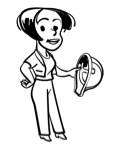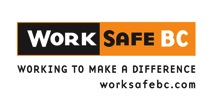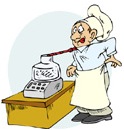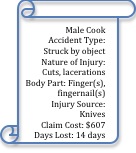WHY FOCUS ON YOUNG WORKERS?
- British Columbia has more than 1 quarter of a million young workers (age 15 – 24 yrs.)
- More than half of workplace accidents involving workers age 15 - 24 occur during the first six months on the job. And almost 20 percent occur during the first month on the job.
- Young males under the age of 25 are at the highest risk for a workplace injury in B.C. The injury rate for young male workers is about 33 percent higher than the overall injury rate in B.C.
- Each hour in B.C. 1 young worker is hurt on the job.
- Each day in B.C., 36 young workers are hurt on the job.
- Every week, five of these workers are permanently injured.
- In 2003, nine young workers were killed in work-related accidents.
WHAT ARE MY HEALTH & SAFETY RIGHTS AND RESPONSIBILITIES IN THE WORKPLACE? You have the right to:
- Education & training about safe work procedures and how to recognize hazards on the job.
- Supervision to ensure that you work without undue risk.
- Equipment & safety gear required to do your job safely (you are responsible for providing your own clothing to protect against the natural elements, general purpose work gloves, safety footwear, and safety goggles)
- You also have the right to refuse unsafe work, if you believe that tasks or conditions are not safe. (You can NOT be fired or disciplined for refusing.)

You are responsible for working without undue risk to yourself or others. To keep safe on the job:
- Don’t assume that you can do something you’ve never done before. Ask your supervisor to show you how before you begin work.
- Ask your employer for job safety training if none is provided.
- Use all safety gear and protective clothing when and where required.
- Always follow safe work procedures and encourage your co-workers to do the same.
- Immediately correct unsafe working conditions or report them right away to your supervisor.
- Know how to handle any hazardous materials or chemicals you use on the job.
- If you have any doubts about your safety, talk to your supervisor.
- Tell your supervisor about any physical or mental conditions that may prevent you from working safely.
- Make suggestions to improve health and safety at your workplace.
WHAT SHOULD I DO IF I AM INJURED?
ALL workers qualify for WCB benefits and services for work-related injuries/illnesses. These benefits can include payment for lost wages and medical costs (i.e. hospital care, health care, medication, surgery).
If you are injured on the job:
- Report the injury to your supervisor or first aid attendant immediately.
- Get medical treatment, if needed.
- Ensure that your employer completes and sends a Report of Injury Form 7 to the Work Experience Department if you receive medical treatment, or if you can’t work as a result of your injury.
TOP SEVEN DANGERS FACING B.C.’S YOUNG WORKERS (from WorkSafe BC website)
The Danger |
# Of young workers injured per year |
Types of jobs |
| 1. Lifting objects – overexertion causing sprains, strains, tears | 1000 |
Retail and grocery clerks, laborers, material handlers, shippers & receivers |
| 2. Working on elevated levels – sprains, strains, tears, & fractures | 700 |
Any job using ladders, stairs, scaffolding, or other raised areas |
| 3. Working with knives – cuts & lacerations | 500 |
Cooks, food service workers, retail clerks & shelf stockers |
| 4. Working with hot substances/object – burns | 400 |
Jobs in the hospitality & service industries |
| 5. Using mobile equipment or motor vehicles –sprains, strains, tears, & fractures | 250 |
Any job requiring driving, riding, operating, or operating near mobile equipment |
| 6. Working with food slicers – cuts & lacerations | 150 |
Deli sales clerks, cooks, food service workers & retail sales clerks in supermarkets |
| 7. Working in proximity to running equipment or machinery – cuts, lacerations, & fractures | 125 |
Laborers in manufacturing or construction, machine operators, material handlers, bakers & cooks |
1. Consider how your job is designed:
- Amount of weight lifted?
- Load lifted from ‘how low’ to ‘how high’?
- Load carried from how far?
- Body twisted with how heavy a load?
- Load lifted how far? • Constant sitting?
- Chair designed for erect & comfortable posture?
- Work surface height & tilt allows for erect posture?
- How much bending, how far, how often, for how long?
2. Use proper lifting rules:
- Tuck your chin
- Keep the load close to your body
- Position your feet before you lift to reduce twisting with the load
- Lift with your legs, trying not to bend at the waist
- If the item is too heavy to lift, ask for help!
3. Use proper ‘ergonomic’ rules for sitting:
- Keep your feet flat on the floor or supported by a foot rest
- Does the back of your chair support your back?
- Place buttocks against the back of the chair
- Pull chair close to your desk
- Align shoulders & hips
4. Let your back recover from the stresses of work:
- Frequently stretch out of your position – do one or two simple stretches at least once every hour
RESTAURANTS – THE #1 INDUSTRY FOR YOUNG WORKER INJURIES
The following table identifies the top accident types for young workers in restaurants & other food services:
Accident Type |
Claims Count 2000-2004 |
% Of Claims 2000-2004 |
| Struck by object | 1,728 |
27% |
| Contact with temperature extremes | 1,234 |
19% |
| Fall on same level | 1,116 |
17% |
| Struck against object | 699 |
11% |
| Overexertion | 539 |
8% |
The following table identifies the top 5 occupations injured for young workers:
Top Occupations Injured |
Number of Claims 2000-2004 |
% Of Claims 2000-2004 |
| Food counter attendants and kitchen helpers | 2,707 |
42% |
| Chefs and cooks | 2,041 |
32% |
| Occupations in food and beverage service | 851 |
13% |
| Cashiers | 207 |
3% |
| Managers in food services and accommodation | 196 |
3% |
The following table provides an overview of injury claim total for the years 2000 – 2004:
Year |
Accepted claims |
Claim costs |
Work days lost |
Serious injuries |
Accepted fatals |
Young worker claims |
% Young worker claims |
| 2000 |
3,249 |
$8,299,561 |
82,499 |
24 |
0 |
1,536 |
47% |
2001 |
3,009 |
$7,446,934 |
71,861 |
29 |
1 |
1,446 |
48% |
2002 |
2,635 |
$7,985,659 |
65,729 |
39 |
1 |
1,164 |
44% |
2003 |
2,444 |
$6,009,651 |
52,997 |
33 |
1 |
1,109 |
45% |
2004 |
2,646 |
$8,234,805 |
60,635 |
27 |
2 |
1,133 |
43% |
Most Dominant Characteristics of
Young Worker
Claimant (15-24 years)
Restaurants
 |
 |
SYSTEM (WHMIS)
The Workplace Hazardous Materials Information System (WHMIS) provides information about many hazardous materials used in the workplace. WHMIS calls these hazardous materials controlled products.
Employers are responsible for educating workers about WHMIS and training workers in safe work procedures. Any person who works with controlled products or in close proximity to controlled products should be trained.
WHMIS covers 6 broad types or classes of hazardous materials, which are lettered A through F. Divisions are provided in some classes to separate different groups of hazardous materials within a class. Symbols are used for these different types of hazardous materials as follows:
 |
CLASS A: COMPRESSED GAS This class includes compressed gasses and gasses liquefied by compression of refrigeration. Example: gas cylinders for oxyacetylene welding or water disinfections. |  |
CLASS D: DIVISION 2: Materials Causing Other Toxic Effects. Materials that cause immediate skin or eye irritation as well as those that can cause long-term effects when repeatedly exposed to small amounts. Examples: acetone, asbestos |
 |
CLASS B: FLAMMABLE AND
COMBUSTIBLE MATERIAL Solids, liquids & gasses capable of catching fire or exploding in the presence of a source of ignition. Examples: white phosphorous, acetone and butane |
 |
CLASS D: DIVISION 3: Biohazardous Infectious Material Materials that can contain harmful microorganisms. Examples: cultures or diagnostic specimens containing salmonella bacteria or the hepatitis B virus |
 |
CLASS C: OXIDIZING MATERIAL Materials which provide oxygen or Similar substance and which increase the risk of fire if they come in contact with Class B materials. Examples: sodium hypocholorite, perchloric acid |
 |
CLASS E: CORROSIVE MATERIAL Acid or caustic materials that can destroy the skin or eat through metals. Examples: muriatic acid, lye |
 |
CLASS D: POISONOUS AND
INFECTIOUS MATERIALS, DIVISION 1- Materials Causing Immediate & Serious Toxic Effects. Materials that can cause death when a person exposed to small amounts. Examples: sodium cyanide, hydrogen sulphide |
 |
CLASS F: DANGEROUSLY REACTIVE MATERIAL Products that undergo dangerous reactions if subjected to heat, pressure, shock or allowed to contact water. Examples: plastic monomers such as butadiene and some cyanides |
EXEMPTIONS:
Some products, such as pesticides, certain consumer products and explosives do not require the distinctive WHMIS hazard symbols and labels because they are already covered by other labeling legislation. WHMIS will require that employers provide instruction to workers for these products based on available information and that various kinds of workplace labeling are used when contents are transferred to new containers.
Appendix D: WCB Regulation 3.12
The right to Refuse Unsafe Work
Refusal of Unsafe Work
3.12 Procedure of refusal
1. A person must not carry out or cause to be carried out any work process or operate or cause to be operated any tool, appliance or equipment if that person has reasonable cause to believe that to do so would create an undue hazard to the health and safety of any person.
2. A worker who refuses to carry out a work process or operate a tool, appliance or equipment pursuant to subsection (1) must immediately report the circumstances of the unsafe condition to his or her supervisor or employer.
3. A supervisor or employer receiving a report made under subsection (2) must immediately investigate the matter and;
(a) Ensure that any unsafe condition is remedied without delay, or
(b) If in his or her opinion the report is not valid, must so inform the person who made the report.
4. If the procedure under subsection (3) does not resolve the matter and the worker continues to refuse to carry out the work process or operate the tool, appliance or equipment, the supervisor or employer must investigate the matter in the presence of the worker who made the report and in the presence of;
(a) A worker member of the joint committee,
(b) A worker who is selected by a trade union representing the worker, or
(c) If there is not a joint committee or the worker is not represented by a trade union, any other reasonably available worker selected by the worker.
5. If the investigation under subsection (4) does not resolve the matter and the worker continues to refuse to carry out the work process or operate the tool, appliance or equipment, both the supervisor, or the employer, and the worker must immediately notify and office, who must investigate the matter without undue delay and issue whatever orders are deemed necessary.